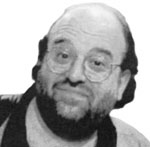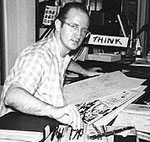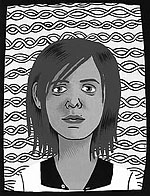>> Top Nine: Yusuf's Choice
>> Alphabetti Fumetti: S is for Shooter
More...

 D is for David, Peter
D is for David, Peter
b. 1956, New Jersey
1985: THE SPECTACULAR SPIDER-MAN; 1987: INCREDIBLE HULK
Whenever I think of Peter David, I think of the Comic Book Guy from THE SIMPSONS. You know the one; the obese, middle-aged virgin with the greasy ponytail and the tight t-shirts that show off his curves. I especially love his haughty voice, honed after years of perching behind the counter of a comic shop ('The Android's Dungeon'), because - to the eyes of a casual observer - an obese, middle-aged virgin has nothing to be haughty about.
Comparing the two probably sounds cruel, and I'm sure Peter David has had far more success with the ladies. But the level and frequency of David's published opinions about his fellow professionals and the state of the industry lead me to imagine them as memos issued in a fit of pique from the desk of the Comic Book Guy. Perhaps when David jumps on the podcasting bandwagon (as he surely will, seeing as he's already a keen blogger), he can convince Hank Azaria to do a reading.
But all of the above is to do David a disservice. He's an accomplished and popular writer, with a definitive twelve-year run on INCREDIBLE HULK and a best-selling series of STAR TREK novels under his belt, and his emotional range is broader than your typical practitioner of genre fiction. Within any one of his stories a reader can find moments of outrageous comedy sitting comfortably alongside scenes of tense action and high drama.
Perhaps his greatest story is one of his first, 'The Death of Jean DeWolf' from SPECTACULAR SPIDER-MAN #107-110, though a handful of stories from his HULK run regarding contemporary issues such as the AIDS virus and mental illness are equally deserving of praise.
David is also something of a hero to a great many people, in part because he has frequently adopted a 'David versus Goliath' stance against his corporate overlords. Several times he has quit writing a title rather than concede to editorial interference or commercial pressure, as with THE INCREDIBLE HULK, X-FACTOR, and SPIDER-MAN 2099, and these matters of principle have earned him no small measure of respect and loyalty. This was most evident when low selling titles like CAPTAIN MARVEL or FALLEN ANGEL would earn a stay of execution because readers would campaign on his behalf.
Currently, he is experiencing a major renaissance in the comics field, with the launch of a new SPIDER-MAN title and a much heralded return to both INCREDIBLE HULK and X-FACTOR. Elsewhere, FALLEN ANGEL has been picked up by independent publishers IDW after cancellation by DC comics. Unlike the Comic Book Guy, Peter David is clearly not someone to be laughed at.
 D is for Ditko, Steve
D is for Ditko, Steve
b. 1927; Johnstown, Pennsylvania
1962: THE AMAZING SPIDER-MAN, DR STRANGE; 1966: CAPTAIN ATOM, BLUE BEETLE, THE QUESTION; 1968: THE CREEPER, THE HAWK AND THE DOVE
In the early 60s, comic books were blessed with something approximating a holy trinity - Stan Lee, Jack Kirby, and Steve Ditko - and together they ushered in the Marvel Age. Ditko is the least prominent of the three, mainly because of his reclusive nature and his peculiar politics, but his contribution to the medium is beyond question.
Most obviously, there is his role in the development of the SPIDER-MAN mythos. Working with Stan Lee, based on preliminary designs by Jack Kirby, they developed this strange, awkward-looking hero with a hidden face and a personal life as tangled as the proverbial web. The lack of facial expression meant that Ditko had to overcompensate through expressive body language, and those early issues of ASM show a Spider-Man who defeated his super-powered opponents through a dizzying choreography of awesome acrobatics.
The pinnacle of Ditko's run on this character came with the celebrated story in AMAZING SPIDER-MAN #33, where Spider-Man is trapped under a massive pile of machinery dumped upon him the previous issue by Doctor Octopus, and the room is slowly filling with water. Spidey spends several pages trying to escape from this predicament, battling against his failing strength and mounting despair, and when he finally escapes it's a momentous triumph not just for our hero, but also for the artist's skills as a sequential storyteller. Unfortunately, Ditko quit drawing the title not long after, supposedly in a dispute over the true identity of the Green Goblin, but the mark he left was indelible.
Ditko's other great collaboration with Lee was DR STRANGE. The character was based in Greenwich Village and fought foes from different planes of reality - mainly, it seemed, by contorting his hands into peculiar gesticulations. The 'Sorcerer Supreme' became a minor celebrity in alternative culture, mainly because of the mind-bending visuals, and hippies assumed that Lee and Ditko were tuned into the same psychedelic substances they were taking. Alas, this wasn't the case - Ditko had an otherworldly imagination that went above and beyond the reach of mind-altering drugs - but the associations were hard to shake.
In 1966 Ditko left Marvel to work for other companies, free to explore his political and philosophical ideas concerning objectivism and moral absolutism. The characters he created for Charlton and DC are most notable in this respect - The Question and Hawk and Dove are literal representations of these beliefs. Indeed, the character of Rorschach from Alan Moore and Dave Gibbon's WATCHMEN is The Question taken to ideological extremes, a vigilante who sees society strictly in terms of black and white, and finds himself increasingly isolated from humanity as a result.
Over the decades Ditko's output has been intermittent, flitting between mainstream comics and small press titles. Since the release of the SPIDER-MAN movies and the attendant media scrutiny he has become even more elusive. Collections of his work for Marvel are still in print, and those comics remain as exciting and visually arresting today as they were when they first appeared. He'll never be as famous as Lee or Kirby, but he never wanted to be. He just wanted to express an idea or two through his art, some of which found an audience. Perhaps that's as much as anyone can ask for?
 D is for Doucet, Julie
D is for Doucet, Julie
b. 1965; Montreal, Canada
1990: DIRTY PLOTTE; 1998: MY NEW YORK DIARY
It's a curious thing how the vast majority of independent comics are autobiographical. Perhaps it's something to do with the medium; the combination of speech balloons and sequential art lends itself as much to personal journalism as it does to popular entertainment. Whatever the cause, the little trickle of memoirs that began with Robert Crumb, Harvey Pekar and Art Speigelman in the 60s and 70s has since developed into a stream of works by the likes of Chris Ware, Joe Sacco, Craig Thompson and Marjane Satrapi. But for all the awards and critical buzz these creators receive, the genre is also in danger of being overwhelmed by morose naval-gazing and inconsequential storytelling.
Canadian cartoonist Julie Doucet is not as well known as the people listed above, but she certainly should be, because she'd give them all a right kick up the arse. Her work is similar to Crumb in that her visual style has a shambolic grandeur; the clothes that people wear, the wreckage of a squalid bedsit, the detritus of a city street - all of it is drawn with an attention to detail that borders on obsession. She also resembles the grand old men of 'comix' in her frank and sometimes brutal honesty about herself and her relationships with members of the opposite sex.
Her work on DIRTY PLOTTE series won her a Harvey Award in 1991 for 'Best New Talent', and in 1998 it was MY NEW YORK DIARY that delivered on that promise. It is an intimate and frequently amusing narrative that chronicles the experience of living with a troublesome boyfriend in the Big Apple. The initial feeling of love and giddy happiness is gradually stripped away to reveal a damaging relationship of jealousy and recrimination, and when Doucet finally walks away by story's end we feel more than a little relieved. It's not just a one sided tale of the 'all men are shit' variety; for every instance of selfishness and manipulation on her boyfriend's part, Doucet recognises something of her own flaws, be it her lack of confidence or her self-destructive behaviour.
Alas, independent comics are a notoriously difficult way to make a living, and Doucet's output in recent years has been sporadic. This is unfortunate, because she's a great practitioner of autobiographical cartoons, and offers a real respite from the self-pitying drivel that the genre is sometimes known for. She's funny, distinctive, and offers some valuable insight into human folly.

This article is Ideological Freeware. The author grants permission for its reproduction and redistribution by private individuals on condition that the author and source of the article are clearly shown, no charge is made, and the whole article is reproduced intact, including this notice.


